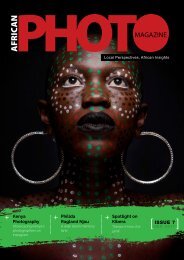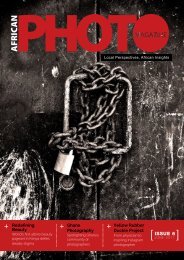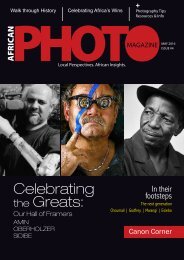African Photo Magazine Issue #8
We are particularly delighted to publish, in this issue, photographers showcasing studio photography talent that echoes the work of one of Africa’s greats, Malick Sidibé (1936–2016). Photographers Hassan Hajjaj, Omar Diop and Samuel Fosso have stayed true to the photographic style that made Mr Sidibé’s work legendary. The portraitures are uniquely stylish and follow signature themes that clearly identify each photographers artistic bent. The work of this trio speaks to the heart of this publication, the genesis of which was to not only celebrate contemporary African photography but to reach back and illuminate the artistry and creativity of our forefathers and those that came before us, and to never forget that we stand on the shoulders of giants.
We are particularly delighted to publish, in this issue, photographers showcasing studio photography talent that echoes the work of one of Africa’s greats, Malick Sidibé (1936–2016). Photographers Hassan Hajjaj, Omar Diop and Samuel Fosso have stayed true to the photographic style that made Mr Sidibé’s work legendary. The portraitures are uniquely stylish and follow signature themes that clearly identify each photographers artistic bent. The work of this trio speaks to the heart of this publication, the genesis of which was to not only celebrate contemporary African photography but to reach back and illuminate the artistry and creativity of our forefathers and those that came before us, and to never forget that we stand on the shoulders of giants.
You also want an ePaper? Increase the reach of your titles
YUMPU automatically turns print PDFs into web optimized ePapers that Google loves.
Meet<br />
Hassan Hajjaj,<br />
the ‘Warhol of<br />
Marrakech’<br />
Who Shot<br />
Hip-Hop Star<br />
Cardi B. for<br />
New York Mag<br />
By Jazia Hammoudi,<br />
news.artnet.com,<br />
November 24, 2017<br />
Born in Larache, Morocco, in 1961,<br />
Hassan Hajjaj left Morocco<br />
for London at an early age. Heavily<br />
influenced by the club, hip-hop, and<br />
reggae scenes of London as well as<br />
by his North <strong>African</strong> heritage, Hajjaj is<br />
a self-taught and thoroughly versatile<br />
artist whose work includes portraiture,<br />
installation, performance, fashion,<br />
and interior design, including furniture<br />
made from recycled utilitarian objects<br />
from North Africa, such as upturned<br />
Coca-Cola crates as stools and<br />
aluminum cans turned into lamps.<br />
Turning to photography in the late 1980s,<br />
Hajjaj is a master portraitist, taking<br />
studio portraits of friends, musicians,<br />
and artists, as well as strangers from<br />
the streets of Marrakech, often wearing<br />
clothes designed by the artist. These<br />
colorful and engaging portraits combine<br />
the visual vocabulary of contemporary<br />
fashion photography and pop art, as well<br />
as the studio photography of <strong>African</strong><br />
artist Malick Sidibe, in an intelligent<br />
commentary on the influences of<br />
tradition in the interpretations of high<br />
and low branding and the effects of<br />
global capitalism.<br />
Hajjaj never studied the medium, it all<br />
came from a love of photography. He<br />
bought a camera from a friend in 1989<br />
and just started taking pictures. He had<br />
two photographer friends who taught<br />
him the basics, and that was it really.<br />
20 africanphotomagazine ISSUE 8 December 2018 21










